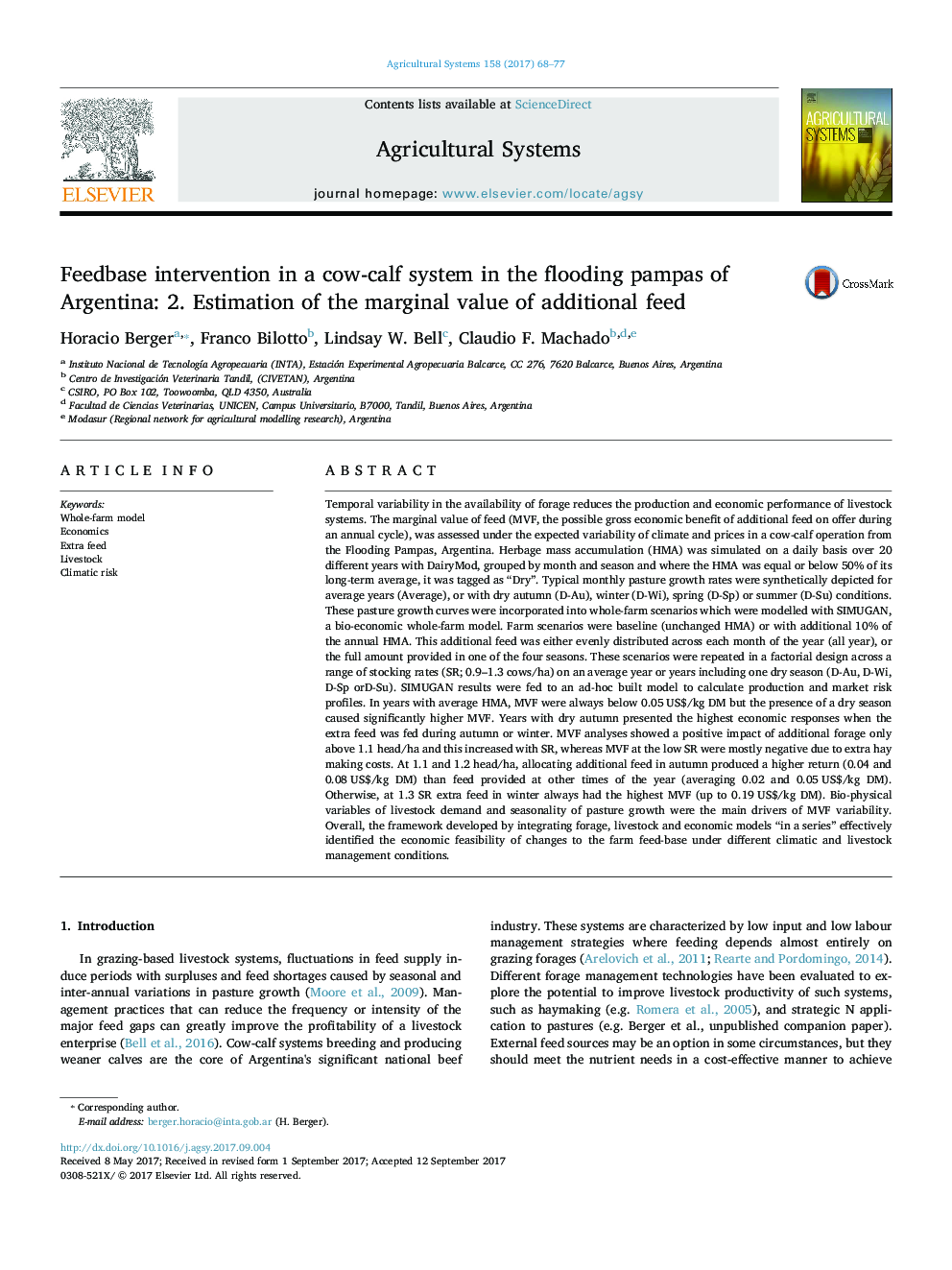| کد مقاله | کد نشریه | سال انتشار | مقاله انگلیسی | نسخه تمام متن |
|---|---|---|---|---|
| 5759682 | 1623212 | 2017 | 10 صفحه PDF | دانلود رایگان |
عنوان انگلیسی مقاله ISI
Feedbase intervention in a cow-calf system in the flooding pampas of Argentina: 2. Estimation of the marginal value of additional feed
ترجمه فارسی عنوان
مداخله تغذیه ای در یک سیستم گاو و گوساله در پمپای سیل آرژانتین: 2. ارزیابی ارزش حاشیه خوراک اضافی
دانلود مقاله + سفارش ترجمه
دانلود مقاله ISI انگلیسی
رایگان برای ایرانیان
کلمات کلیدی
مدل مزرعه کل، اقتصاد، خوراک اضافی، دامداری، خطر آب و هوا،
موضوعات مرتبط
علوم زیستی و بیوفناوری
علوم کشاورزی و بیولوژیک
علوم کشاورزی و بیولوژیک (عمومی)
چکیده انگلیسی
Temporal variability in the availability of forage reduces the production and economic performance of livestock systems. The marginal value of feed (MVF, the possible gross economic benefit of additional feed on offer during an annual cycle), was assessed under the expected variability of climate and prices in a cow-calf operation from the Flooding Pampas, Argentina. Herbage mass accumulation (HMA) was simulated on a daily basis over 20 different years with DairyMod, grouped by month and season and where the HMA was equal or below 50% of its long-term average, it was tagged as “Dry”. Typical monthly pasture growth rates were synthetically depicted for average years (Average), or with dry autumn (D-Au), winter (D-Wi), spring (D-Sp) or summer (D-Su) conditions. These pasture growth curves were incorporated into whole-farm scenarios which were modelled with SIMUGAN, a bio-economic whole-farm model. Farm scenarios were baseline (unchanged HMA) or with additional 10% of the annual HMA. This additional feed was either evenly distributed across each month of the year (all year), or the full amount provided in one of the four seasons. These scenarios were repeated in a factorial design across a range of stocking rates (SR; 0.9-1.3Â cows/ha) on an average year or years including one dry season (D-Au, D-Wi, D-Sp orD-Su). SIMUGAN results were fed to an ad-hoc built model to calculate production and market risk profiles. In years with average HMA, MVF were always below 0.05Â US$/kg DM but the presence of a dry season caused significantly higher MVF. Years with dry autumn presented the highest economic responses when the extra feed was fed during autumn or winter. MVF analyses showed a positive impact of additional forage only above 1.1Â head/ha and this increased with SR, whereas MVF at the low SR were mostly negative due to extra hay making costs. At 1.1 and 1.2Â head/ha, allocating additional feed in autumn produced a higher return (0.04 and 0.08Â US$/kg DM) than feed provided at other times of the year (averaging 0.02 and 0.05Â US$/kg DM). Otherwise, at 1.3 SR extra feed in winter always had the highest MVF (up to 0.19Â US$/kg DM). Bio-physical variables of livestock demand and seasonality of pasture growth were the main drivers of MVF variability. Overall, the framework developed by integrating forage, livestock and economic models “in a series” effectively identified the economic feasibility of changes to the farm feed-base under different climatic and livestock management conditions.
ناشر
Database: Elsevier - ScienceDirect (ساینس دایرکت)
Journal: Agricultural Systems - Volume 158, November 2017, Pages 68-77
Journal: Agricultural Systems - Volume 158, November 2017, Pages 68-77
نویسندگان
Horacio Berger, Franco Bilotto, Lindsay W. Bell, Claudio F. Machado,
